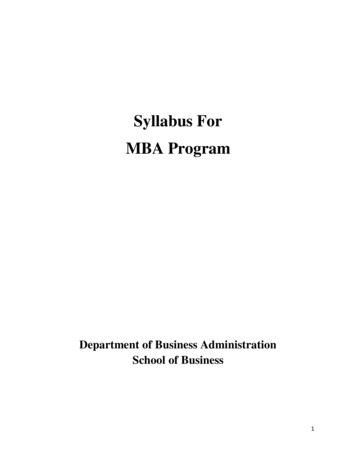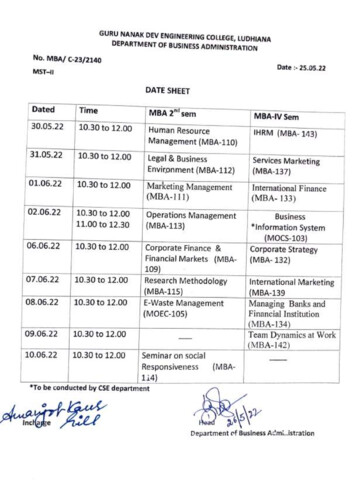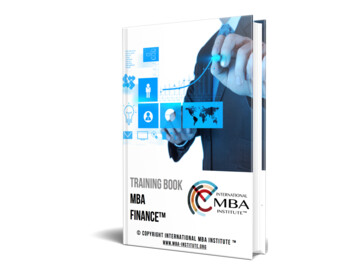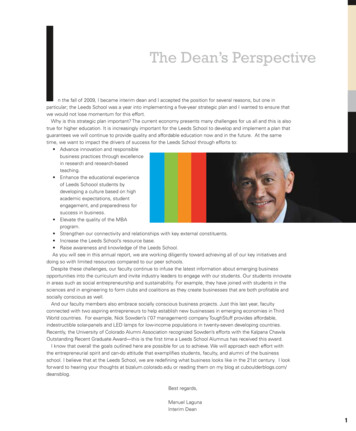
Transcription
Syllabus ForMBA ProgramDepartment of Business AdministrationSchool of Business1
Overview of the ProgramMaster of Business Administration (MBA) program provides an opportunity for individuals toprepare for managerial position in today’s complex and dynamic environment. The programplaces strong emphasis on the application of business theory to the realities of the businessworld. It also recognizes the demands of an increasing, competitive, multicultural economycharacterized by rapid technological innovation and superior product and service qualitydemands. The MBA degree program consists of a prescribed pattern of Graduate courses. Theentire program is based on a common core of courses, which examine the functions of theexecutive and the environment of the administrator. Beyond this core, the student may choose tostudy in some depth any of a number of particular fields in business administration andeconomics. The School of Business is dedicated to develop leaders and teach fundamentalbusiness concepts. The Master of Business Administration (MBA) of UCTC is designed to offera student with a special set of leadership knacks that are extremely treasured in the globalmarketplace. Students will get to know how to become an innovative leader. MBA at UCTC isuniquely positioned to deliver such leaders. Over the course of MBA at UCTC, students will beprovided with a range of option units and specialist focus areas.Goals and Objectives: To provide students with the required tools for decision-making and data analysis. To improve students' marketing skills through the use of case studies. To teach students the techniques and tools useful for financial analysis and control. To give students the skills and the knowledge set necessary for productivity andperformance. To develop each student's strategic thinking.Learning Objectives: Critical concepts and tools those are relevant to achieve leadership and organizationalobjectives and goals. To develop and strengthen various emotional intelligence skills. To provide students with the required tools for decision-making and data analysis. To improve students' marketing skills through the use of case studies. To teach students the techniques and tools useful for financial analysis and control intoday's business climate. To give students the skills and the knowledge set necessary to ethically manage today'sbusiness operations for productivity and performance. To engender a global perspective in all students. To develop each student's strategic thinking.Objectives: MBA Program's learning Critical thinking. Effective problem solving. Effective communication - both oral and written communication. Leadership. The ability to innovate. Critical AnalysisDegree Requirements for MBA Program:The Department of Business Administration offers MBA programs having 61 credit hours (CH)and 37 credit hours Master of Business Administration (MBA) Programs on the basis of thebackground of the intakes. Usually non BBA graduate required to complete 61 credit hours2
within 4 semesters and the BBA graduate has to complete 37 credits within 2 semesters. Thereare three types of courses in the program which are Foundation Courses, Core Courses andSpecialized Courses. All students are required to undertake either Internship/OCP or Dissertationwhich has a defense session at the end of the last semester.Admission Requirements for MBA Program:Admission to the MBA program is selective. To apply for admission, students must fulfill therequirements outlined below:1. Successful completion of at least a Bachelor degree from a reputed university.2. Qualifying in a UCTC admission tests or a minimum score of 550 in TOEFL and 500 inGMAT.3. Work experience after graduation in an executive position is preferred but not essential(For regular MBA only).Evaluation System:AttendanceClass test, AssignmentCase study and presentationMid-Term ExaminationFinal ExaminationTotal10%10%10%30%40%100%Grading System (UGC approved)Department of Business Administration follows University Grants Commission (UGC)approved grading system. This grading system is also used by the other departments ofUniversity of Creative Technology Chittagong. The performance of the students in the coursework is evaluated by letter grading systems as described below:Marks Range80% and above75% to below 80%70%to below 75 %65% to below 70%60% to below 65%55% to below 60%50% to below 55%45% to below 50%40% to below 45%Less than 40%GradeA AAB BBC CDFGrade pretationOutstandingExcellentVery GoodGoodSatisfactoryAbove AveraqeAverageBelow AveragePassFailI0.00IncompleteDistribution of Courses:Types of CoursesNo. of CoursesFoundation Courses8 Courses @ 3 credit hoursCore Courses7 Courses @ 3 credit hoursSpecialized Courses4 Courses @ 3 credit hoursComprehensive Viva@1 credit hourInternship/ Dissertation/ OCP/Project1 Courses @ 3 credit hoursWorkTotalCredit Hours242112103613
Semester wise Course Distribution (non BBA Graduate)First SemesterFoundation CoursesSl.Course 202Course TitleCredit HoursContact HoursPrinciples of AccountingFundamentals of ManagementBusiness Mathematics & StatisticsBusiness CommunicationResearch Methods in Business3333333333Course TitleCredit HoursContact HoursPrinciples of MarketingManagement Information SystemsManagerial Finance333333Managerial AccountingHuman Resource Management &Organizational Behavior3333Credit HoursContact Hours333333333312121313Second SemesterFoundation CoursesSl.Course CodeNo.1MKTG-42012MIS-42013FIN-4101Core Courses4ACC-52025MGT-5202Third SemesterCore CoursesSl.Course 5303Course TitleManagerial EconomicsInternational BusinessProduction ManagementStrategic ManagementQuantitative Analysis in BusinessFourth SemesterSpecialized Courses1Four Courses from any one of the major areas23Comprehensive VivaInternship/ Dissertation/ OCP/ Project Work4
Specialized Areas (Any one):1. Accounting & Information Systems2. Finance and Banking3. Human Resources Management4. Marketing5. Supply Chain Management1. Accounting & Information 08ACC-5509ACC-5510ACC-5511ACC-5512Course TitleCredit HoursContact HoursAccounting Information SystemsCorporate Financial AccountingStrategic Cost AccountingStrategic Managerial AccountingHuman Resource AccountingGovernment Accounting3333333333332. Finance and Banking:Sl.CourseCourse TitleNo.Code01 BNKG-5501 Bank Management02FIN-5503Corporate Finance03FIN-5504International Financial Management04FIN-5506Financial Derivatives & Engineering05FIN-5508Investment & Portfolio Management06FIN-5509Public FinanceCredit HoursContact Hours333333333333Credit HoursContact Hours3333333333333. Human Resource Management:Sl. CourseNo. Code01 HRM-5507Course TitleHuman Resource Planning &DevelopmentHuman Resource AccountingConflict Management & NegotiationCompliance of Labor LawCompensation ManagementInternational Human ResourceManagement5
4. Marketing:Sl. Course CodeNo.01 MKTG-550402 MKTG-550603 MKTG-550804 MKTG-551005 MKTG-551106 MKTG-5512Course TitleConsumer BehaviorMarketing ResearchPromotional ManagementBrand MarketingSupply Chain ManagementStrategic MarketingCredit HoursContact Hours3333333333335. Supply Chain 3SCM-5505SCM-55060506SCM-5507SCM-5508Course TitleSupply Chain Planning, Design andEvaluationPurchasing And Supply ManagementMaterial ManagementStrategic Supply Chain and LogisticsManagementDistribution SystemsInternational TradeCredit Hours Contact Hours3333333333336
Semester wise Course Distribution (BBA Graduate)First SemesterCore CoursesSl.Course -5303MGT-5304Course TitleCredit HoursContact Hours333333333333Credit HoursContact Hours3366661313Managerial AccountingHuman Resource Management &Organizational BehaviorManagerial EconomicsInternational BusinessProduction ManagementStrategic ManagementSecond SemesterCore CoursesSl.Course CodeNo.1QTM-5303Course TitleQuantitative Analysis in BusinessSpecialized Courses2Two of first three courses from any one of themajor areas3Two of last three courses from any one of themajor areas45Comprehensive VivaInternship/ Dissertation/ OCP/ Project WorkSpecialized Areas:1. Accounting & Information Systems2. Finance and Banking3. Human Resources Management4. Marketing5. Supply Chain Management1.Sl.No.010203040506Accounting & Information ACC-5511ACC-5512Course TitleCredit HoursContact HoursAccounting Information SystemsCorporate Financial AccountingStrategic Cost AccountingStrategic Managerial AccountingHuman Resource AccountingGovernment Accounting3333333333337
2. Finance and Banking:Sl.CourseCourse TitleNo.Code01 BNKG-5501 Bank Management02FIN-5503Corporate Finance03FIN-5504International Financial Management04FIN-5506Financial Derivatives & Engineering05FIN-5508Investment & Portfolio Management06FIN-5509Public FinanceCredit HoursContact Hours333333333333Credit HoursContact HoursHuman Resource Planning &DevelopmentHuman Resource AccountingConflict Management & NegotiationCompliance of Labor LawCompensation ManagementInternational Human ResourceManagement333333333333Course TitleCredit HoursContact Hours3333333333333. Human Resource Management:Sl. CourseNo. Code01 HRM-5507Course Title4. Marketing:Sl. Course CodeNo.01 MKTG-550402 MKTG-550603 MKTG-550804 MKTG-551005 MKTG-551106 MKTG-5512Consumer BehaviorMarketing ResearchPromotional ManagementBrand MarketingSupply Chain ManagementStrategic Marketing5. Supply Chain 3SCM-5505SCM-55060506SCM-5507SCM-5508Course TitleSupply Chain Planning, Design andEvaluationPurchasing And Supply ManagementMaterial ManagementStrategic Supply Chain and LogisticsManagementDistribution SystemsInternational TradeCredit Hours Contact Hours3333333333338
Course Contents of Master of Business AdministrationCourse Title: Principles of AccountingCourse Code: ACC-4101Credit Hours: 3 Contact Hours: 3Course ObjectivesThis course aims at providing basic knowledge on principles and concepts of accounting andmaking them to understand the accounting cycle and their applications in different categories ofbusiness entities. It will highlight the underlying theoretical concepts and basic accountingpractices.Mid –term Examination1. Introduction: Defining accounting, Purpose and nature of accounting information,Historical background of accounting, users of accounting information, accountingorganizations, Branches of accounting, Types of business organizations, accountingconcepts and principles, accounting equation, and Financial Statements.2. Recording Business Transactions: T accounts, Meaning of assets, Liabilities, Owner’sequity, Expenses and revenues, Double entry systems: transaction analysis, Books oforiginal entry/ journal, ledger, and trial Balance.3. Adjusting process: Capital and revenue expenditure and its distinction. Accrual basis vscash basis accounting, Adjustment to the accounts, Posting and adjusting entries, Closingand reversal entries, adjusted trial balance, Preparation of financial statements fromadjusted trial balance.4. Completing the Accounting Cycle: Overview of the accounting cycle, Preparation ofwork sheet, Format of balance sheet, and preparation of financial statement from worksheet.Final Examination5. Accounting for merchandising Operations: Accounting for purchase and sale ofinventory, Adjusting and closing process of merchandising businesses, Preparation ofworksheet and financial statements.6. Bank Reconciliation Statement: Definition, reasons for reconciliation, advantages ofreconciliation, Methods of reconciliation, phases in the reconciliation process, terms usedin the bank reconciliation statement, preparation of bank reconciliation statement.7. Plant Assets-Acquisition, Use& Disposal: Definition of plant assets; Classification ofplant assets; usage of plant assets; Acquisition & treatment of tangible assets; Methods tocalculate depreciation; Treatment of depreciation.8. Accounting for inventories: Definition of inventory; inventory classification; inventoryaccounting system; Recording entries under periodic and perpetual inventory system;Cost allocation Methods-FIFO, LIFO& Average costing.RECOMMENDED BOOKS:1. Financial Accounting by Charles T. Horngren and Walter T Harrission Jr., (2 nd Edition)2. Cost Accounting Planning and Control, MatzUsry, 8th Edition, South- WesternPublishing Co.Reference:3. Accounting Principles BY Weygandt, Kieso& Kimmel (6th Edition)9
Course Title: Fundamentals of ManagementCourse Code: MGT-4101Credit Hours: 3 Contact Hours: 3Course ObjectivesThis course presents a thorough and systematic coverage of management theory and practice. Itfocuses on the basic roles, skills and functions of management, with special attention tomanagerial responsibility for effective and efficient achievement of goals. Upon completion ofthe course, students are expected to understand fundamental concepts and principles ofmanagement, including the basic roles, skills, and functions of management; knowledgeable ofhistorical development, theoretical aspects and practice application of managerial process; befamiliar with interactions between the environment, technology, human resources, andorganizations in order to achieve high performance; and be aware of the ethical dilemmas facedby managers and the social responsibilities of businesses.1.2.3.4.Mid-term ExaminationIntroduction: Who are managers? Levels of management, What is management?,functions of management, Management roles, Management skills, How the manager’sjob is changing, what is an organization, Characteristics of organization, traditionalorganization vs contemporary organization, Why study management? the universality ofmanagement, rewards and challenges of being a manger.Management yesterday and today: Historical background of management, Scientificmanagement, principles of scientific management, important contributions, How dotoday’s managers use scientific management?, general administrative theory, importantcontributions-Henri Fayol, Max Weber,Fayol’s 14 principles of management, How dotoday’s managers use general administrative theories, Quantitative approach, Behavioralapproach ,Hawthrone studies, the systems approach, the contingency approach, currenttrends and issues of management.Decision Making: the essence of the manager’s job: Definition, decision makingprocess, making decisions: rationality, bounded rationality, and intuition, types ofproblems and decisions, decision-making conditions, decision making styles, Decisionmaking biases and errors.Planning: Definition of planning, purposes of planning, planning and performance, Howdo mangers plan?, the role of goals and plans in planning, types of plans, establishinggoals and developing plans, approaches to establishing goals-traditional approach: topdown, MBO approach, developing plans, contemporary issues in planning, criticisms ofplanning, effective planning in dynamic environment, planning tools and techniques.Final Examination5. Organizing: Organizing process, defining organizational structure, elements oforganizational structure-work specialization, departmentalization, chain of command,span of control, centralization and decentralization, formalization , organizational designdecisions, mechanistic and organic organizations, contingency factors, commonorganizational design, traditional organizational design, contemporary organizationaldesigns, today’s organizational design challenges, Line and staff organization, delegationof authority, factors determining delegation of authority, process of delegation ofauthority.6. Communication: Definition of communication, process of communication, importanceof communication, levels of communication, types of communication, principles of10
communication, causes of breakdown in communication in the organization,improvement of communication in the organization.7. Human resource management (HRM): Importance of HRM, process of HRM- HRplanning, recruitment and decruitment, selection, orientation training, performancemanagement, compensation and benefits, career development.8. Motivating employees: concept of motivation, early theories of motivation,contemporary theories of motivation, integrating contemporary theories of motivation,current issues in motivation,9. Leadership: Who are leaders and what is leadership? differences between a leader and amanager, early leadership theories-trait theories, behavioral theories, contingencytheories of leadership-Fiedler, Hersey-Blanchard, leader participation, and path-goal,transformational-transactional leadership, charismatic-visionary leadership, teamleadership, leadership issues in the 21 st century-managing power, developing trust,providing ethical leadership, empowering employees, cross-cultural leadership, genderdifferences and leadership, the demise of celebrity leadership, substitutes for leadership.10. Foundations of control: What is control? Why is control important? the control processmeasuring, comparing, taking managerial actions, controlling for organizationalperformance, what is organization performance? Measures of ck controls, financial controls, balanced scorecard, informationcontrols, benchmarking of best practices, contemporary issues in control.Recommended Books1. Text: Stephen P Ronnins Latest editionReferences:2. Management- Griffin(Latest edition)3. Management- Stoner(Latest edition)4. Management –Koontz(Latest edition)Course Title: Business Mathematics & StatisticsCourse Code: QTM – 4101Credit Hours: 3 Contact Hours: 3Course ObjectiveThe main objective of this course is to build up the mathematical & statistical knowledge of thestudents related to the business decision-making and testing purpose. This course providesinvaluable tools for analysis and perceiving new directions in various disciplines. At present,business executives face a complex situation than ever before. To clarify a complex situation andto make a proper decision, the use of mathematics and statistics are essential. In this regard,every business student should have necessary knowledge on these areas. This course coverscomprehensive understanding of mathematics and statistics related to business analysis anddecision-making.Mid-term Examination1. Equation & Function: Introduction to equation, Degree of an equation, Types ofequations, Solving systems of equations, Application of equations in Business.Introduction to function, Different types (algebraic & business) of functions, Graphicalsolution of linear and nonlinear functions, Business applications of functions.2. Coordinate Geometry: Introduction, Quadrants, Coordinates, Intercepts, Coordinates ofMid-point, Distance between two points, Straight line, Different forms of equations ofstraight line, Intersection point of two lines, Graph of linear and nonlinear functions.11
Concept of slope, Types of slope, Formula for finding the slope, Business applications ofCoordinate Geometry.3. Matrix algebra: Introduction to matrix, Types of matrices, Properties of matrices,Matrix operations, Determinant, Properties of determinant, Minor & Co-factor, Somespecial types of matrices, Finding the inverse of a matrix, Matrix presentation of a systemof linear equation, Solving Systems of Linear Equation, Business application of Matrix.4. Basics of Calculus: Differential & Integral: Introduction to differential calculus,Derivative and differentiation, Rules of differentiation for one variable function, Businessapplications of differential calculus. Introduction to integral calculus, Integration andIntegral, Indefinite Integral, Definite Integral, Rules of integration, Business applicationsof integral calculus.Final Examination5. Introduction to Basic statistics: Definition and scope of statistics; classification andorganization of statistical data; attributes and variables; constructing frequencydistributions for grouped and ungrouped data; drawing of graphs, charts and diagrams.6. Measures of Central Tendency: Mean: Arithmetic mean, geometric mean & harmonicmean; median and mode (for grouped and ungrouped data); quartiles, deciles andpercentiles; graphical determination of median and mode, miscellaneous problems.7. Measures of Dispersion, Skewness and Kurtosis: Introductory concepts; range, quartiledeviation and its coefficient; mean deviation and its coefficient; coefficient of variation;raw and central moments, determination of skewness and kurtosis.8.Probability: Meaning of probability; some basic terminologies; simple andcompound events; independent events; sample space; simple and conditional probability;some examples on probability; laws of probability, Bayes theorem.9. Index Numbers: Definition and concepts; Types of Index Numbers; Laspeyre’s index,Paasche’s index, Bowley’s index, Fisher’s ideal index, Marshall-Edge worth index; timereversal test and factor reversal test; cost of living index; chain indices; miscellaneousproblems.10. Time-Series Analysis: Definition and concepts; components of time-series;measurement of trend and seasonal variations; method of semi-average; moving averagemethod; method of least squares assuming linear and non-linear relationship; ratio totrend method; use of time-series in business analysis.Recommended BooksBasic Text Books1. Mathematics for Managerial Decisions-Robert L. Childress, Robin D. Gorsky, RichardM. Witt.2. Statistics for Management - R. Levin & D. S. RubinReference Books:3. Business Mathematics - V. K. Kapoor4. Business Statistics - S. P. Gupta and M. P. Gupta12
Course Title: Business CommunicationCourse Code: BCOM-4101Credit Hours: 3 Contact Hours: 3Course ObjectiveThis course presents communication as integral to management strategy and as a criticalcomponent for success in the workplace. In this class, you will develop a foundation fordesigning effective messages, both written and oral, from concept to delivery. You will use astrategic communication model to identify objectives, analyze audiences, choose information,and create the most effective arrangement and channel for that message. Particularly, the courseemphasizes elements of persuasive communication: how to design messages for diverse andpossibly resistant audiences and how to present that information in a credible and convincingway.Mid-Term Examination1. Fundamentals of Business Communication: Define Business Communication,Communication business and you, Process of Business Communication, Types ofBusiness Communication, Methods of Business Communication, Barriers to BusinessCommunication, 7C’s of Business Communication, Effective Communication, Benefitsof effective communication, Essentials of Effective communication, Technology used forBusiness Communication.2. Mastering Listening And Non-Verbal Communication:Define, Improving Nonverbalcommunication, Recognizing Nonverbal Communication. Using Non verbalcommunication effectively, listening Carefully, Communication Networking3. Communication in Teams: Define Team, Types of Teams, Advantages andDisadvantages of Teams, Team Roles, Phases of team evolution, Guidelines for asuccessful collaborative communication, Group Dynamics.4. Communicating Intercultural: Define Culture, Define Intercultural Communication,Advantages of Multicultural Workforce, Recognizing Cultural Variation., and Checklistfor communicating effectively across cultures, Differences between low context and highcontext culture.Final Examination5. Business Etiquettes and Professional Grooming: What is Etiquette? Why etiquette isimportant for business? Professional Etiquette, Dinning Etiquette, Office Etiquette,Telephone Etiquette, Email Etiquette, Body Language.6. Business Letters: Circular Letter, Letter of Enquiry, Claims and adjustments letter,Refusal letter, Collection letter7. Tools of Internal Communication: Memorandum, Notice, Types of Meetings, Meetingminutes, Difference between meetings and proceedings.8. Business Report Writing: Types, Contents of a Business report, Format of a businessreport, Short report Vs Long Report. Analytical Vs Informative report9. Appendix: Business Terms, Abbreviations of Business terms and organizations13
Recommended Books1. Excellence in business Communication -John V. Thill and Courtland L. Bovee (7thEdition)2. Communication for Business –A practical Approach -Shirley Taylor (Fourth Edition)3. Business Communication-Prof. Muhammad Mohiuddin (Second Edition)4. Business Communication-M. Omar Ali (Third Edition)Course Title: Managerial FinanceCourse Code: FIN-4101Contact Hours: 03 Credit Hours-03Objectives of the CourseManagerial finance has an important place in the business organization. The main purpose of this courseis to generate the fundamental knowledge of finance to the business graduates. This course provides thedetermination of funds, identification of sources, selection of sources, collection of funds, efficient use offunds and dividend decision. The course also affords the business graduates to introduce with thefinancial resources that are traded in global financial markets and how to evaluate those financialresources for financing as well as investment decisions. The course also generates the knowledge of riskmeasurement, management, valuation of financial assets to the students of school of business. At thecompletion of course successfully, the business graduates would stand themselves as intellectuals offinance.Mid-term Examination1. An Overview of Finance: Meaning, Career in Finance, Functions, organization structure ofFinance, Goals of corporation, Agency relationship & problems, & Managerial actions tomaximize the shareholder wealth.2. Financial Statement Analysis: Meaning, Ratios, Types, uses, Limitations, Problems &Practices.3. Risk and Rate of Return: Meaning: Risk & Return, Types, sources, Relationship betweenRisk & Return, Beta and CAPM, & Problems and Practices.4. Mathematics of Finance: Meaning, significance, Simple & compounding, Annuities: Sinkingfund, Pension fund and Amortization.Final Examination5. The Cost of Capital: Definition, Factors, Components of Cost of Capital, WACC, andProblems & Practices.6. The Capital Structure and Leverage: Definition, Business & Financial risk, Leverages,Optimal Capital Structure, Capital Structure Theories, Problems & Practices.7. The Basics of Capital Budgeting: Meaning, Importance, Project Classifications, Techniques,Rationales, NPV Profile and Cross over Rate, Problems and Practices.8. Dividend Policy: Meaning: Dividend, Dividend Policy & Decision, Types, Factors, Theories,Problems & Practices.9. Working Capital Management: Definition, Managing Current Assets, Financing CurrentAssetsRecommended Books and References:1. Fundamentals of Financial Management- by Bringham & Houstom2. Foundations of Financial Management- by Block & Hirt14
Course Title: Principles of MarketingCourse Code: MKTG-4201Contact Hours: 03 Credit Hours-03Course ObjectivesThe purpose of this course is to prepare the student to identify the marketing mix components inrelation to market segmentation; explain the economic, psychological, sociological, and globalfactors which influence consumer and organizational decision-making processes; and interpretmarket research data to forecast industry trends and meet customer demands. This course willhelp students develop the understanding and skills necessary to become successful marketers.This course integrates the approaches, and places an emphasis on decision-making. Sevenperspectives of marketing: global, relationship, ethics, customer value, productivity, technology,and entrepreneurship are included in this course. Principles of Marketing is not just abouttextbook learning: it challenges students to use their critical and creative skills in all aspects ofMarketing, not just those covered in this course.Mid- Term Examination1. Understanding marketing: Marketing definition, understanding the marketplace anddemand, designing a customer driven marketing strategy, marketing philosophiesbuilding customer relationships, the new marketing landscape.2. The Marketing Environment: The company's microenvironment - The company’smacro environment- Demographic Environment, Economic environment- NaturalEnvironment, Technological Environment, Political Environment and CulturalEnvironment, Responding to the Marketing Environment.3. Strategic Planning, Implementation and Control: Nature of Strategic Planning,Corporate and Divisio n Strategic Planning, Business Unit Strategic Planning- TheMarketing Process4. Market segmentation, market targeting and positioning: Requirements of EffectiveSegmentation, Segmenting Consumer Markets and Business Markets, Selecting TargetMarket Segments, Differentiation and Positioning.Final Examination5. Dealing With Competition: Micheal porter five forces model, Market leader strategy,challenger, follower, nicher strategy, Cases6. Marketing Mix Decisions: Designing Products: Definition, Product Classification, IndividualProduct Decisions, Building strong brands, product line decisions, Product Life-cycle Strategies,Pricing Products: Factors to consider when setting prices, General Pricing Approaches, PlacingProducts: Nature of distribution channel, Channel Design Decision, Channel managementdecisions. Promoting Products: Setting the total promotion budget, Advertising, Sales Promotion,Public Relations, Personal Selling and Direct marketing.7. Analyzing Consumer Market: What influences consumer behavior? Cultural Factors, SocialFactors, Personal Factors, Key psychological processes, The buying decision process.15
8.
Admission Requirements for MBA Program: Admission to the MBA program is selective. To apply for admission, students must fulfill the requirements outlined below: 1. Successful completion of at least a Bachelor degree from a reputed university. 2. Qualifying in a UCTC admission tests or a minimum score of 550 in TOEFL and 500 in GMAT. 3.











